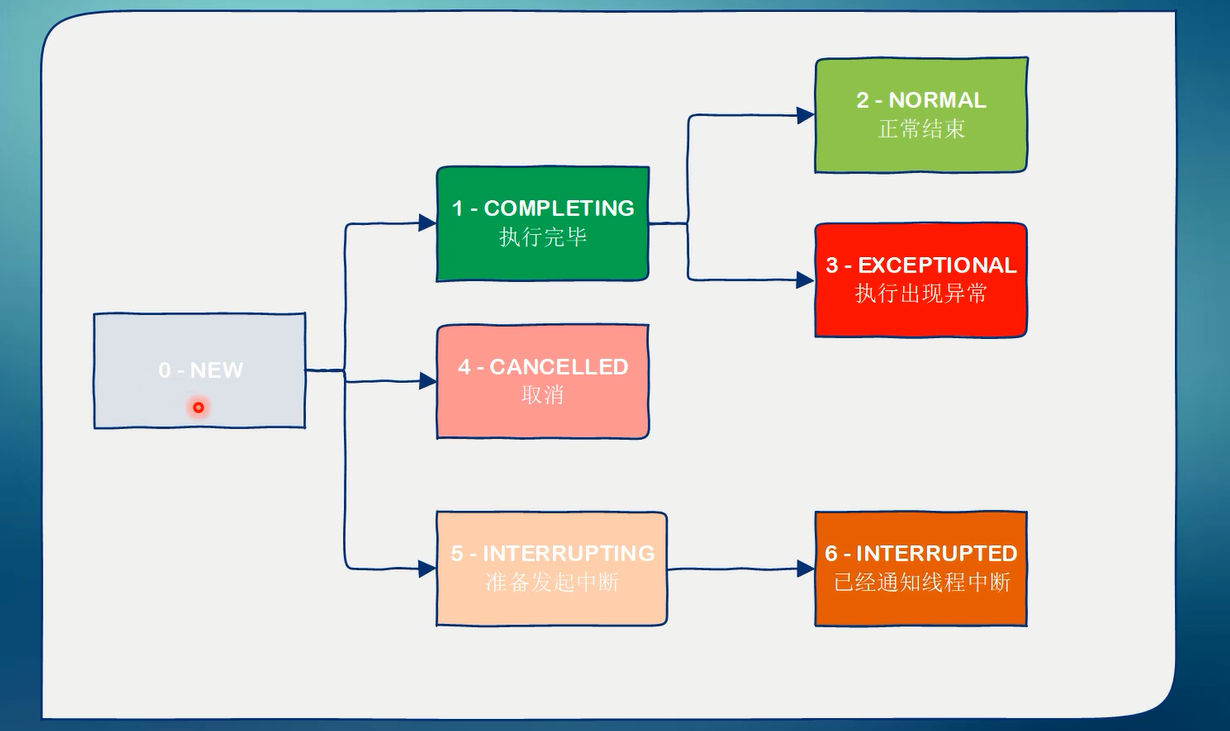两种构造方式:
1. public FutureTask(Callable<V> callable) { if (callable == null) throw new NullPointerException(); this.callable = callable; this.state = NEW; // ensure visibility of callable } // 可以传runnable,但是因为是void run(),所以想要有结果返回需要特殊处理,即传个准备接收结果的东西进来 2. public FutureTask(Runnable runnable, V result) { this.callable = Executors.callable(runnable, result); this.state = NEW; // ensure visibility of callable }
一、一个FutureTask为什么三种构造能放到一个线程中执行?
//FutureTask实现了RunnableFuture接口 public class FutureTask<V> implements RunnableFuture<V>
我们看下RunnableFuture接口,继承了Runnbale和Future接口,所以可以放在线程中执行。
//RunnableFuture接口继承了Runnable和Future接口。 public interface RunnableFuture<V> extends Runnable, Future<V> { /** * Sets this Future to the result of its computation * unless it has been cancelled. */ void run(); }
二、在一个线程中如何调用Callable方法?
一个小例子:RealData1实现了Callable接口,同时模拟了一个费时操作。

class RealData1 implements Callable<String>{ private String para; RealData1(String para) { this.para = para; } @Override public String call() throws Exception { StringBuilder sb = new StringBuilder(); for (int i = 0; i < 10; i++) { sb.append(para); } try { // 这里使用sleep,模拟很慢的构造RealData过程 Thread.sleep(4000); } catch (InterruptedException e) { e.printStackTrace(); } return sb.toString(); } }
Main方法:

import java.time.LocalTime; import java.util.concurrent.*; public class FutureMainJDK { public static void main(String[] args){ // future本身是一个runnable FutureTask<String> future = new FutureTask<>(new RealData1("a")); new Thread(future).start(); System.out.println("请求完成"); try { // 这里代表其他任意操作 System.out.println(LocalTime.now()); Thread.sleep(2000); System.out.println(LocalTime.now()); } catch (InterruptedException e) { e.printStackTrace(); } try { System.out.println("数据=" + future.get()); System.out.println(LocalTime.now()); } catch (InterruptedException | ExecutionException e) { e.printStackTrace(); } } }
我们知道,起一个线程,它执行的是起线程的对象的run方法,那我们来看一下FutureTask的run方法。
public void run() { if (state != NEW || !UNSAFE.compareAndSwapObject(this, runnerOffset, null, Thread.currentThread())) return; try { Callable<V> c = callable; if (c != null && state == NEW) { V result; boolean ran; try { //注意这里,实现Callable接口,有这个call方法。 result = c.call(); ran = true; } catch (Throwable ex) { result = null; ran = false; setException(ex); } if (ran) set(result); } } finally { // runner must be non-null until state is settled to // prevent concurrent calls to run() runner = null; // state must be re-read after nulling runner to prevent // leaked interrupts int s = state; if (s >= INTERRUPTING) handlePossibleCancellationInterrupt(s); } }
好,果然,可以看到FutureTask的run方法里调用了call(),也就是说线程通过FutureTask的run方法,来调用Callable的call方法,call方法真正的实现在实现Callable接口的类中。
三、如何拿到FutureTask返回的结果呢?
get方法:
public V get() throws InterruptedException, ExecutionException { int s = state; if (s <= COMPLETING) //通过状态位判断完成否 s = awaitDone(false, 0L); return report(s); }
awaitDone
private int awaitDone(boolean timed, long nanos) throws InterruptedException { //可以看到是可以设置等待的超时时间的,咱们现在没设 final long deadline = timed ? System.nanoTime() + nanos : 0L; WaitNode q = null; boolean queued = false; for (;;) { if (Thread.interrupted()) { //如果当前线程被中断,则把包含本线程的等待节点移除 removeWaiter(q); throw new InterruptedException(); } //不断的来获取当前的状态位state大小,只有大于COMPLIING时才返回 //注意一下,这里状态位的设置是在run方法里调用的set方法设置的,下面贴出来 int s = state; if (s > COMPLETING) { if (q != null) q.thread = null; return s; } else if (s == COMPLETING) // cannot time out yet Thread.yield(); else if (q == null) q = new WaitNode(); else if (!queued) queued = UNSAFE.compareAndSwapObject(this, waitersOffset, q.next = waiters, q); else if (timed) { nanos = deadline - System.nanoTime(); if (nanos <= 0L) { removeWaiter(q); return state; } LockSupport.parkNanos(this, nanos); } else //不断的循环相当于做了一个自旋锁,会park当前线程 LockSupport.park(this); } }
run方法里调用的set方法,分为三个步骤:
① 先将状态位设为COMPLETING,把call方法的结果放到outcome里
②将state状态位设为NORMAL
③finishCompletion,完成通知,实际上就是unpark,下面会细说这里。
protected void set(V v) { if (UNSAFE.compareAndSwapInt(this, stateOffset, NEW, COMPLETING)) { outcome = v; UNSAFE.putOrderedInt(this, stateOffset, NORMAL); // final state finishCompletion(); }
}
好,做完上面这些分析,我们已经能够理解FutureTask怎么跑起来和怎么拿到任务,注意一下get方法会阻塞调用线程,没拿到结果之前,他就一直Park着,那么接下来的问题就是:
四、什么时候unpark了阻塞线程?
看看上面的set方法,调用了finishCompletion(),这其实就是那个unpark。
private void finishCompletion() { // assert state > COMPLETING;
// 通知所有的WaitNode,可以unpark了 for (WaitNode q; (q = waiters) != null;) { if (UNSAFE.compareAndSwapObject(this, waitersOffset, q, null)) { for (;;) { Thread t = q.thread; if (t != null) { q.thread = null;
//注意这里,unpark了 LockSupport.unpark(t); } WaitNode next = q.next; if (next == null) break; q.next = null; // unlink to help gc q = next; } break; } } done(); callable = null; // to reduce footprint }
cancel方法也会调用这个finishCompletion。
最后上个状态变化图

